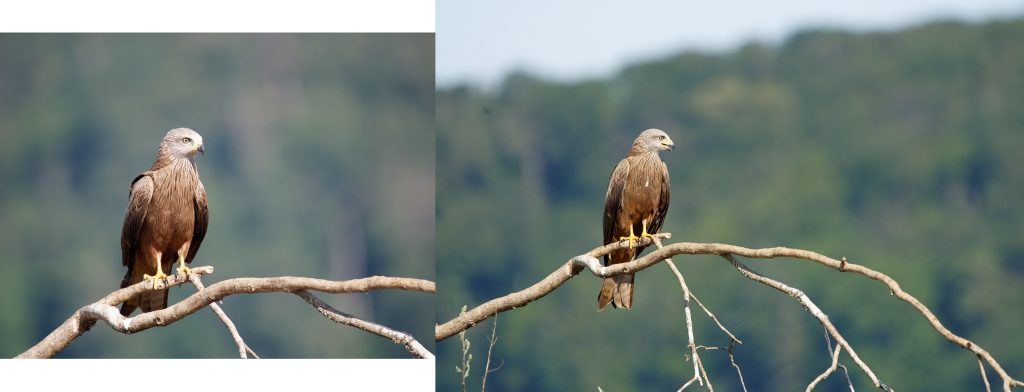Expensive OMDS/Oly vs. affordable Sony gear
Here’s a highly unfair comparison. That is so because the cost delta between the two body/lens combination I am comparing is substantial:
- OMDS OM-1 with Olympus 150-400mm f/4.5 lens with built-in 1.25x TC (about $9,700)
- Sony A7iV with Sony 200-600mm f/5.6-6.3 lens (about $4,500)
Just to be clear, I don’t have enough ground to stand on for an extensive comparison between these two sets of gear. All I have to offer are a few pictures of the same subjects shot with these two combos, plus a few facts about both rigs. You can compare those and draw your own conclusion but won’t have a complete picture. These shots were taken when a close friend who owns the Sony gear, and I with my Oly, spent a day in a bird hide, patiently sitting side by side. He was kind enough to share some of his resulting images with me and give me permission to use them here. I do not claim that these pictures, his and/or mine, tell you much about either combo, but if you wondered how these two combos might stack up against each other, this might at least clue you in.
Let’s start with a little background info for those not 100% familiar with both systems:
The OM-1 is a 20.4 megapixel micro four-thirds (MFT) body. MFT means it has a MUCH smaller sensor than the Sony (about 25% of the Sony’s sensor size). It also means that the lens has a crop factor of 2x, so the Olympus lens has a full-frame equivalent focal range of 300mm (short end, TC disabled) to 1000mm (long end, TC engaged).
The A7iv is a 33 megapixel full-frame body, so it pegs the 200-600mm lens against the 300-1000mm Olympus in this comparison. In other words, the OMDS/Olympus combo has a 40% advantage in focal length, whereas the Sony has a 62% advantage in total pixels. Let’s do the math: this means that if shooting a subject that fills the frame at 1000mm, the resulting image with the OMDS/Olympus combo has 20.4 megapixels, whereas the same subject would produce a cropped image size of about 11.9 megapixels on the Sony gear.
Both bodies were introduced in 2022. The Sony body is actually more expensive than the OM-1, but that is much more than offset by the $7,500 Olympus lens. On the flip side, the OMDS/Oly gear, in spite of its much longer focal length, weighs a combined 2,474 grams, significantly less than the Sony’s 3,069 grams (both with hood). The OM-1 has a few capabilities that the Sony lacks, such as ProCapture. A few hints for those unfamiliar with the feature: in this mode, the OM-1 keeps recording images into the buffer continually while the shutter is half-pressed, always discarding the oldest images for the newest. Once you fully press the shutter, everything that is currently in the buffer gets written to the card. In a nutshell, this means you can capture much more than one second’s worth of continuous shots taken BEFORE you pressed the shutter. This allows you to capture shots that are otherwise fiendishly difficult to get, such as of a bird rapidly taking off from a twig.
Alright, let’s look at the images. I’ve got four sets of them for you. For each, I first show you the RAWs, converted to JPEGs in DxO PhotoLab with no further editing whatsoever. Then, you get significantly edited JPEGs that aim to make these shots as comparable as possible by cropping to (about) the same size of the subject in the image frame. All of these images were shot in good light, so there is little noise to be found.
Set 1: Eurasian Magpies


The RAW images point to the different focal lengths (Sony @ 600mm, Oly @ 1000mm FF equivalent), where the higher need to crop on the Sony wipes out that body’s pixel count advantage. The JPEG crop is thus quite a bit larger with the Oly, at 3424 x 2568px, than with the Sony at 2453 x 1840 px. Color-wise, the two cameras look similar, though the Sony’s greens appear more pronounced.
Set 2: Black Kite


Again shot at 600mm resp. 1000mm. The JPEG crops are 2470 x 3294px (Oly) and 1832 x 2748 px (Sony). What struck me as odd is that I had to boost orange and red on the Sony JPEG to match the bird’s brown chest color of the OM-1, whereas the two RAWs, converted without any further edits, looked quite similar. I have to attribute this to PhotoLab’s RAW conversion process.
Set 3: Eurasian Marsh-Harrier



This is a third example of shots taken at 600mm resp. 1000mm. The JPEG crops are 4190 x 3143px (Oly) and 3321 x 2491 px (Sony). The orange/red color difference was the same here.
Set 4: Black Kite taking off


These shots are different inasmuch as I had zoomed out wider to make sure I’d get several captures of the bird in flight. My FL on the Oly was thus only 532mm (FF equivalent), whereas the Sony was still at 600mm. Because of this and the different image orientation, my friend got significantly more pixels on the bird now: 2443 x 1833px (Oly) vs 2852 x 3803 px (Sony). The orange/red color difference again existed. My friend says he missed the focus a bit, as becomes evident when zooming to 100% on the bird’s eye, but this was easy to correct by using Topaz Sharpen AI when creating the JPEG.
On all of my shots, please note that the lens’ built-in teleconverter was engaged. Given this, I find the resolution of the MFT images quite remarkable (and verified this in many other tests): with or without the TC engaged, the image quality is nearly identical. External TCs usually cause a bit more of an IQ hit since their design always requires compromises across all lenses they are supposed to work with.
One last point worth mentioning, though I did not confirm it myself, is that the Sony is considered to be a bit front heavy, while the Olympus lens feels well balanced. This would potentially matter even more when putting a TC on the Sony, but it matters mostly when shooting hand-held, not when shooting from a tripod.
My conclusions
The OMDS/Oly shots have a clear resolution advantage, as they should do given the much longer focal length of the lens (hey, spending more than $5K MORE should buy you SOMETHING). You get more detail with it (look at the magpies’ feet, for example) Personally, I also prefer the OMDS/Oly shots for their slightly nicer bokeh, but these differences are small and a Sony fan might view them differently anyway. Overall, the Sony combo performed well given its relatively low cost. If you looked at the JPEGs full-screen on a ‘normal’ monitor, you’d be hard-pressed to decide which is which. In other words, you can get great shots with either rig, and the Sony one is a steal for what it delivers. If the higher weight of the Sony combo doesn’t bother you, it is a good choice at its price.
I am happy that my friend’s gear performs as well as it does. However, since cost isn’t too much of a concern for me, I still prefer my OMDS/Oly gear. It delivers more resolution, gives you a better view of the bird in the EVF, weighs much less, has far better weather protection, and has tricks up its sleeve, such a ProCapture, that the Sony set doesn’t. Plus, as the old bird shooting adage goes, “Nothing beats long focal length, except for LONGER focal length”. 😉
Along these lines, one might argue that my friend should have used a 1.4x TC, maybe even a 2x one, to shoot at focal lengths similar to mine. For some of the images, this might be true, but one needs to keep in mind that at f/11 with the 1.4x, or f/16 with the 2x, a) the external TC will cause some loss of sharpness/resolution and b) AF and ISO levels take a hit,, especially when shooting moving subjects.
Lothar Katz
August 2022